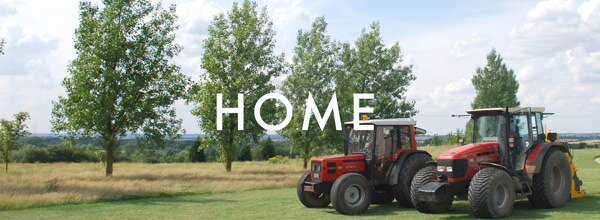PORTFOLIO - SPORTS TURF DRAINAGE - Aspatria RUFC
Aspatria RUFC
Sports Pitch Drainage Installation 2012 & 2015
Turfdry was first contacted by Aspatria RUFC's Chairman / Head Groundsman, John Heyworth in 2008 regarding the proposed completion of new drainage to the club’s training pitches that had only been partially installed in 2005. A site visit was made and detailed proposals were designed and priced. John was immediately very interested in the unique Turfdry Drainage System using Hydraway Sportsdrain as an alternative to a conventional plastic pipe drainage system. He applied for RFU assistance in funding the project and, although not immediately forthcoming, it was approved in 2011. By this time Turfdry had successfully completed the 2010 installation of a similar Turfdry Drainage System for Marple Rugby Club, Cheshire (see case study).
Several contractors were invited to tender for the proposed works at Aspatria and Turfdry proved its competitiveness by submitting the best price for a traditional two-tier scheme, as well as submitting a similar price for a single-tier Turfdry Drainage System with Hydraway Sportsdrain at 3-metre spacing. Though the RFU’s appointed agronomists still favoured the traditional two-tier (plastic pipe and slit-drain) drainage system, John Heyworth had thoroughly researched the Turfdry Drainage System was adamant that he wanted to try it at Aspatria. His views were further reinforced by a site visit to Marple RFC and discussions with that club’s Chairman, Richard Hammersley, who was delighted with Turfdry’s system in comparison with previously installed traditional systems that had delivered disappointing results.
The Turfdry Drainage System was eventually given the green light and installed at Aspatria in May 2012. The system had an early test when 54mm (>2 inches) of rain fell on 21st-22nd June, and John reported to those involved with the project that, "I am delighted to report that all the newly drained pitch's area is clear of surface water and playable following the downpour over the last 24 hours or so. All the inspection points showed running water in the collector pipes."
In recognition of his dedication and overall efforts in effecting pitch improvements at Aspatria RUFC, John was awarded the prestigious Institute of Groundsmanship (IOG), National Volunteer Groundsman of the Year award in 2013. Further information about this and John’s involvement with the RFU can be found in an article featured in Pitchcare magazine: "Aspatria RUFC - The Appliance of Science".
The performance of the Turfdry Drainage System on the training pitches continued to impress, and comparisons began to show the 1st XV pitch in a bad light. In February 2014, John sent out the following photo of the flooded 1st XV pitch, with the comment, "Nothing of any note on the ones you drained!"
Partly in response to this, Sport England funding was granted to enable Aspatria RUFC to have the 1st XV pitch similarly drained - scheduled for after the 2014-2015 season. Furthermore, this scheme was to be an official Sport England ‘Pilot Scheme’ for the Turfdry Drainage System. In October 2014, John emailed the following photo of the 1st XV pitch flooded again after heavy rain on 3rd & 4th October, which forced the Saturday home game to be postponed.
In his email, John pointed out that there had been virtually no rain for six weeks or so prior to this event, and that the 1st XV pitch had been aerated twice during that period. He also highlighted the contrast with the grassed areas in the background of the photo, showing, "the adjacent 2nd XV pitch which has Hydraway drains installed & there is no surface water whatsoever. Justification once again for the Sport England grant for the 1st XV pitch & the efficiency of the Hydraway system installed using the RFF grant 2 years ago".
As part of the requirements for the Sport England ‘Pilot Scheme’ soil analysis - including infiltration rate testing - was undertaken prior to the works to enable comparative measurements to be made after the installation.
Works got underway in late April; ground conditions were difficult and the definition of ‘boulder clay’ - “heavy, sticky soil full of hard rocks” was evident for all to see.
The project was then affected by extreme wet weather that brought the works to a temporary halt, before completion was finally achieved at the very end of May. The combination of difficult ground conditions and adverse weather made this one of the more challenging drainage installation projects faced by Turfdry, whose M.D. Melvyn Taylor freely admitted that the company’s trademark objective of ‘minimum disturbance’ was not achieved in this instance.
Nevertheless, all those involved recognised the efforts of Turfdry’s team to achieve satisfactory completion in difficult circumstances and everyone was eager to see how the new drainage system would perform. The summer and early autumn of 2015 were dry and it was not until 11th November, after a week of very wet weather, that John was able to report his initial satisfaction. He had been monitoring the flow in the drainage system’s outfall chamber and commented that “water was pouring out at considerable velocity”.
John was pleased to have finally had some severe rain to test the system but he was unaware that not only Aspatria’s pitch drainage, but also the whole of Cumbria was about to be tested by the wettest winter on record. In his role as Cumbria’s RFU Facilities Coordinator, John Heyworth visits clubs in the county to carry out pitch inspections and on 3rd December 2015 he was doing so accompanied by the RFU’s Head Groundsman Keith Kent, and the RFU’s Northern Regional Facilities Manager, Alex Bowden. The following day John sent out an email to all those involved with the choice of the Turfdry Drainage System for the 1st XV pitch at Aspatria, as follows:
Gentlemen
Last evening there was a severe downpour in NW Cumbria & the Western Lakes, about 75mm rain in 2 hours I am told.
Aspatria was cut off by flooded rivers & roads, the road to Carlisle impassable etc. I actually drove back from Ambleside at about 5pm following a pitch inspection with Keith & Alex in severe downpour conditions: very hairy & impassable in a petrol-engine car. I think I was fortunate to get home when I did.
I was informed that Aspatria's pitch was under "a foot of water" but I couldn't go to see for myself as the road was impassable & had a flood at home. The main cause was apparently floodwater running like a river from a field adjacent to our club property. A problem we are aware of & are addressing with the owner.
However when I went to inspect the pitch this morning there was no sign of any surface water on the pitch, it was in excellent condition not even" squidgy" underfoot & easily dry enough to play on. I only mention this as testament to the efficiency of the Hydraway System & how pleased we are that we chose it in preference to conventional systems. It exceeded the expectations of the unbelievers!
Prior to the installation this summer we undoubtedly would have had a residual lake on the pitch which would have taken at least a week to subside without the help of pumps.
Chapeau to Hydraway & Turfdry!
John
Another committee member at Aspatria RUFC, Mel Hanley, echoed John’s comments:
I can vouch for that john as I was down last night. I should have put floodlights on to take a pic as evidence. We had equivalent of last December’s rainfall in a few hours...same tonight as well...remarkable how it was this morning...we could have played on it...regards.
Mel
Though Cumbria was battered by unrelenting storm systems during the winter of 2015/16 Aspatria’s pitch continued to be in use throughout, and indeed had greater use than normal, often in wet conditions. Indeed, the most rainfall ever recorded in the UK was on 4th-5th October 2015 at Honister Pass - a mere 18 miles from Aspatria - when 231.4mm (13.44 inches) of rain was recorded! The increased resiliance of the pitch in these conditions did actually lead to its overuse, which caused some problems with surface compaction and loss of soil structure, but John Heyworth addressed these issues with end of season aeration and sand banding to return the pitch to optimal performance.
PSD Agronomy has carried out independent soil infiltrometer tests on the pitch as one means of assessing the effectiveness of the Turfdry Drainage System. Tests were done at the north and south ends of the pitch in March 2015 prior to the drainage installation and produced an overall average infiltration rate of 5mm/hr. The first post-drainage tests in July 2014 gave a comparable average result of 49mm/hr. When tested again in April 2016 following the record wet winter and soil structure damage due to overuse in wet and frozen conditions, the result was 7.5mm/hr., but after these issues were addressed infiltration rates rose again dramatically. In January 2017, the average was 34mm/hr., more than 6X greater than prior to the Turfdry Drainage System being installed.
The benefits of improved drainage amount to much more than reducing the number of fixtures lost to waterlogging. The January 2016 PSD Agronomy Pitch Inspection reported that, “The general sward condition was assessed as being good with ground cover being recorded as 90%, a significant improvement on the previous assessment (62.6%)”. Not all of this improvement may be necessarily directly attributable to the Turfdry Drainage System but a knowledgeable groundsman like John Heyworth is aware that he is fighting a losing battle to produce and maintain a good grass sward if a rugby pitch is susceptible to frequent and prolonged waterlogging. The plant leaf suffers as a result of sitting in water and the root system does not develop sufficiently because its water requirements are adequately satisfied at shallow depth. Shallow rooting is a major cause of poor sward coverage, and has long been recognised by John as a problem at Aspatria. The situation has improved since the Turfdry Drainage System was installed, with PSD reporting in January 2016: “roots were evident to 160mm but were rather weak and spindly at these depths. Greater root density and vigour was observed in the upper 40-80mm of the profiles in the assessed areas”.
Project Summary |
Services Provided by Turfdry
AddressAspatria Rugby Club |

















